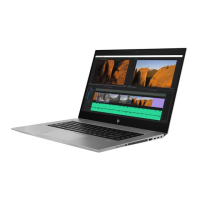
Do you have a question about the HP ZBook Studio G5 and is the answer not in the manual?
| Form factor | Clamshell |
|---|---|
| Product type | Mobile workstation |
| Product color | Gray |
| Country of origin | China |
| Market positioning | Performance |
| LED backlight | Yes |
| RGB color space | NTSC |
| Display diagonal | 15.6 \ |
| Display brightness | 400 cd/m² |
| Native aspect ratio | 16:9 |
| Maximum refresh rate | 72 Hz |
| Bus type | DMI |
| Processor cache | 12 MB |
| Processor cores | 6 |
| Processor model | E-2176M |
| Processor frequency | 2.7 GHz |
| Processor cache type | Smart Cache |
| Configurable TDP-down | 35 W |
| Processor manufacturer | Intel |
| Processor boost frequency | 4.4 GHz |
| Configurable TDP-down frequency | 2.2 GHz |
| Discrete GPU manufacturer | NVIDIA |
| Discrete graphics card model | NVIDIA® Quadro® P1000 |
| On-board graphics card model | Intel UHD Graphics P630 |
| Discrete graphics card memory | 4 GB |
| Discrete graphics memory type | GDDR5 |
| Memory slots | 2x SO-DIMM |
| Internal memory | 32 GB |
| Memory clock speed | 2666 MHz |
| Internal memory type | DDR4-SDRAM |
| Maximum internal memory | - GB |
| Memory layout (slots x size) | 2 x 16 GB |
| SSD capacity | The Solid State Drive's storage capacity in Gigabytes. |
| SSD interface | NVMe, PCI Express |
| Storage media | SSD |
| SSD form factor | M.2 |
| Total storage capacity | 512 GB |
| Compatible memory cards | SD |
| Number of SSDs installed | 1 |
| Front camera HD type | HD |
| Antenna type | 2x2 |
| Bluetooth version | 5.0 |
| Top Wi-Fi standard | Wi-Fi 5 (802.11ac) |
| WLAN controller model | Intel Dual Band Wireless-AC 9560 |
| USB 2.0 ports quantity | 0 |
| USB 3.2 Gen 1 (3.1 Gen 1) Type-A ports quantity | 2 |
| Pointing device | Clickpad |
| Operating system architecture | 64-bit |
| HP segment | Business |
| Battery capacity | 95.6 Wh |
| AC adapter power | 150 W |
| Sustainability certificates | ENERGY STAR |
| Intel Identity Protection Technology version | 1.00 |
| Depth | 254 mm |
|---|---|
| Width | 360 mm |
| Weight | 2000 g |
| Height (rear) | 17.4 mm |
| Height (front) | 8.8 mm |
Provides essential safety warnings and precautions to prevent injury or damage.
Identifies and describes components located on the right side of the computer.
Identifies and describes components located on the left side of the computer.
Identifies and describes components related to the computer's display assembly.
Details the components and functionality of the keyboard and touchpad area.
Explains the function of various indicator lights on the computer.
Describes the power button, speakers, and fingerprint reader locations and functions.
Identifies and explains the function of special keys on the keyboard.
Details the functions of action keys and how to use them.
Identifies and describes components located on the bottom of the computer.
Explains the location and purpose of various labels affixed to the computer.
Provides an exploded view and part numbers for the main computer components.
Lists and illustrates the components included in the Plastics Kit.
Details the individual parts that make up the display assembly.
Lists and illustrates various mass storage devices and their part numbers.
Illustrates the components included in the Bracket Kit and their part numbers.
Lists various miscellaneous parts and their associated part numbers.
Outlines necessary tools, considerations, and precautions before component replacement.
Introduces procedures for replacing internal computer components.
Lists HP support resources and outlines general troubleshooting methodology.
Covers identifying issues, analyzing boot sequences, failure classification, and environmental checks.
Advises on visual inspection, updating BIOS/drivers, and analyzing recent changes.
Introduces HP diagnostic tools like UEFI, HPSA, BCU, and Thermal Monitor for hardware testing.
Explains how to interpret status lights, blinking codes, and POST error messages.
Details hard reset, soft reset, CMOS clearing, and reseating cables.
Explains testing with minimum configuration, safe mode, and verified working configurations.
Outlines when and how to replace the system board as a troubleshooting step.
Addresses no power, intermittent power, AC adapter, and battery issues.
Covers POST issues, BIOS errors, OS performance, shutdowns, blue screens, and freezes.
Discusses display anomalies, touch screen, keyboard, USB, network, and audio issues.
Addresses storage device problems, noises, fans, and thermal issues.
Explains how to use the computer's BIOS setup utility for configuration.
Provides steps to restore BIOS settings and install BIOS updates.
Explains downloading BIOS updates and changing boot order via F9.
Details TPM settings and using HP Sure Start for BIOS security.
Explains how to use HP PC Hardware Diagnostics on Windows for hardware testing.
Provides instructions for downloading HP PC Hardware Diagnostics Windows versions.
Explains how to use HP PC Hardware Diagnostics UEFI for hardware testing.
Explains how to use Windows tools for backing up personal information and system recovery.
Details how to create HP Recovery media using HP Recovery Manager.
Outlines options for restoring, refreshing, and resetting the computer.
Lists detailed technical specifications for the computer.
Details the specifications for M.2 PCIe solid-state drives.
Lists the specifications for M.2 solid-state drives.
Explains the usage and characteristics of nonvolatile memory types in HP computers.
Provides answers to common questions regarding BIOS, TPM, and HP Sure Start.
Explains how to use HP Sure Start for BIOS monitoring and protection.
Lists general requirements for power cord sets applicable to all countries.
Details specific requirements for power cord sets in various countries and regions.